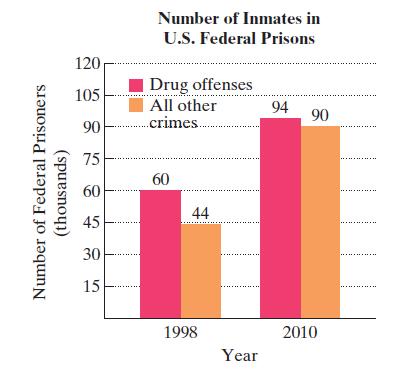Harsh, mandatory minimum sentences for drug offenses account for more than half the population in U.S. federal
Question:
Harsh, mandatory minimum sentences for drug offenses account for more than half the population in U.S. federal prisons. The bar graph shows the number of inmates in federal prisons, in thousands, for drug offenses and all other crimes in 1998 and 2010. (Other crimes include murder, robbery, fraud, burglary, weapons offenses, immigration offenses, racketeering, and perjury.)
 a. In 1998, there were 60 thousand inmates in federal prisons for drug offenses. For the period shown by the graph, this number increased by approximately 2.8 thousand inmates per year. Write a function that models the number of inmates, y, in thousands, for drug offenses x years after 1998.
a. In 1998, there were 60 thousand inmates in federal prisons for drug offenses. For the period shown by the graph, this number increased by approximately 2.8 thousand inmates per year. Write a function that models the number of inmates, y, in thousands, for drug offenses x years after 1998.
b. In 1998, there were 44 thousand inmates in federal prisons for all crimes other than drug offenses. For the period shown by the graph, this number increased by approximately 3.8 thousand inmates per year. Write a function that models the number of inmates, y, in thousands, for all crimes other than drug offenses x years after 1998.
c. Use the models from parts (a) and (b) to determine in which year the number of federal inmates for drug offenses was the same as the number of federal inmates for all other crimes. How many inmates were there for drug offenses and for all other crimes in that year?
Step by Step Answer:






